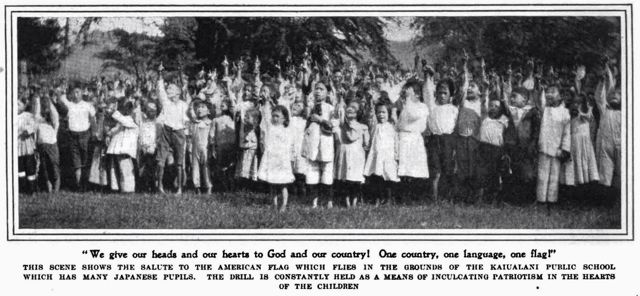Under International Law Native Hawaiians Are Victims of Genocide
ASIA--PACIFIC, 16 May 2016
Hawaiian Kingdom Blog – TRANSCEND Media Service
8 May 2016 – Under international humanitarian law, which includes the law of occupation and the protection afforded civilians who are not engaged in war, denationalization is not only a war crime but is synonymous with the term genocide. Since the occupation of the Hawaiian Kingdom began during the Spanish-American War, the United States embarked on a deliberate campaign of forced denationalization in order to conceal the occupation and militarization of a neutral State. Denationalization, in its totality, is genocide.
Prior to World War I, violations of international law did not include war crimes, or, in other words, crimes where individuals, as separate and distinct from the State or country, could be prosecuted and where found guilty be punished, which included the death penalty. The Commission on the Responsibility of the Authors of the War and on Enforcement of Penalties (Commission on Responsibility) of the Paris Peace Conference of 1919 took up the matter of war crimes after World War I (1914-1918). The Commission identified 32 war crimes, one of which was “attempts to denationalize the inhabitants of occupied territory.”
Although the 1907 Hague Convention, IV, did not specify the term “denationalization” as a war crime, the Commission on Responsibility relied on the preamble of the 1899 Hague Convention, II, which states, “Until a more complete code of the laws of war is issued, the High Contracting Parties think it right to declare that in cases not included in the Regulations adopted by them, populations and belligerents remain under the protection and empire of the principles of international law, as they result from the usages established between civilized nations, from the laws of humanity and the requirements of the public conscience.” This preamble has been called the Martens clause, which was based on a declaration read by the Russian delegate, Professor von Martens, at the Hague Peace Conference in 1899.
In October of 1943, the United States, the United Kingdom and the Soviet Union established the United Nations War Crimes Commission (UNWCC). World War II had been waging since 1939, and atrocities committed by Germany, Italy and Japan drew the attention of the Allies to hold individuals responsible for the commission of war crimes. On December 2, 1943, the UNWCC adopted by resolution the list of war crimes that were drawn up by the Commission on Responsibility in 1919 with the addition of another war crime—indiscriminate mass arrests. The UNWCC was organized into three Committees: Committee I (facts and evidence), Committee II (enforcement), and Committee III (legal matters).
Committee III was asked to draft a report expanding on the war crime of “denationalization” and its criminalization under international law. Committee III did not rely solely on the Martens clause as the Commission on Responsibility did in 1919, but rather used it as an aid to interpret the articles of the 1907 Hague Convention, IV. It, therefore, concluded that “attempts to denationalize the inhabitants of occupied territory” violated Article 43, where the occupying State must respect the laws of the occupied State; Article 46, where family honor and rights and individual life must be respected; and Article 56, where the property of institutions dedicated to education is protected.
In 1944, Professor Raphael Lemkin first coined the term “genocide” in his publication Axis Rule in Occupied Europe (p. 79-95). The term is a combination of the Greek word genos (race or tribe) and the Latin word cide (killing). The 1919 Commission on Responsibility did list “murders and massacres; systematic terrorism” as war crimes, but Professor Lemkin’s definition of genocide was much broader and more encompassing.
 According to Professor Lemkin, “Generally speaking, genocide does not necessarily mean the immediate destruction of a nation, except when accomplished by mass killings of all members of a nation. It is intended rather to signify a coordinated plan of different actions aiming at the destruction of essential foundations of the life of national groups, with the aim of annihilating the groups themselves. The objectives of such a plan would be disintegration of the political and social institutions, of culture, language, national feelings, religion, and the economic existence of national groups, and the destruction of the personal security, liberty, health, dignity, and even the lives of the individuals belonging to such groups.”
According to Professor Lemkin, “Generally speaking, genocide does not necessarily mean the immediate destruction of a nation, except when accomplished by mass killings of all members of a nation. It is intended rather to signify a coordinated plan of different actions aiming at the destruction of essential foundations of the life of national groups, with the aim of annihilating the groups themselves. The objectives of such a plan would be disintegration of the political and social institutions, of culture, language, national feelings, religion, and the economic existence of national groups, and the destruction of the personal security, liberty, health, dignity, and even the lives of the individuals belonging to such groups.”
“Genocide has two phases,” argued Professor Lemkin, “one, destruction of the national pattern of the oppressed group; the other, the imposition of the national pattern of the oppressor. This imposition, in turn, may be made upon the oppressed population which is allowed to remain, or upon the territory alone, after removal of the population and the colonization of the area by the oppressor’s own nationals. Denationalization was the word used in the past to describe the destruction of a national pattern.” Professor Lemkin believed that denationalization was inadequate and should be replaced with genocide.
The term genocide, however, was not a war crime under international humanitarian law at the time, but it appears that Committee III was in agreement with Professor Lenkin that it should be a war crime. The problem that faced Committee III was how to categorize genocide as a war crime under the Hague Convention, IV. On September 27, 1945, Committee III argued that denationalization was not a single act of “depriving the inhabitants of the occupied territory of their national characteristics,” but rather a program that attempted to achieve this result through: “interference with the methods of education; compulsory education in the language of the occupant; … the ban on the using of the national language in schools, streets and public places; the ban on the national press and on the printing and distributing of books in the language of the occupied region; the removal of national symbols and names, both personal and geographical; [and] interference with religious services as far as they have a national peculiarity.”
Committee III also argued that denationalization included other activities such as: “compulsory or automatic granting of the citizenship of the occupying Power; imposing the duty to swearing the oath of allegiance to the occupant; the introduction of the administrative and judicial system of the occupying Power, the imposition of its financial, economic and labour administration, the occupation of administrative offices by nationals of the occupying Power; compulsion to join organizations and associations of the occupying Power; colonization of the occupied territory by nationals of the occupant, exploitation and pillage of economic resources, confiscation of economic enterprises, permeation of the economic life through the occupying State or individuals of the nationality of the occupant.”
Committee III also stated that these activities by the occupying State or its nationals would also “fall under other headings of the list of war crimes.”
There were apparent similarities between Professor Lemkin’s definition of genocide and the Committee III’s definition of denationalization. Professor Lemkin argued that genocide was more than just mass murder of a particular group of people, but “the specific losses of civilization in the form of the cultural contributions which can only be made by groups of people united through national, racial or cultural characteristics (Lemkin, Genocide as a Crime under International Law, 41 AJIL (1947) 145, at 147).” Similarly, Committee III argued that denationalization “kill[s] the soul of the nation,” and was “the counterpoint to the physical act of killing the body, which was ordinary murder (Preliminary Report of the Chairman of Committee III, C.148, 28 Sept. 1945, 6/34/PAG-3/1.1.0, at 2).”
In its October 4, 1945 report “Criminality of Attempts to Denationalise the Inhabitants of Occupied Territory,” Committee III renamed denationalization to be genocide.
On December 11, 1946, the General Assembly of the United Nations adopted a resolution that declared genocide a crime under the existing international law and recommended member States to sign a convention. After two years of study, the General Assembly adopted the Convention on the Prevention and Punishment of the Crime of Genocide on December 9, 1948. By the Convention, genocide has been recognized as a crime even when there is no war or the occupation of a State. Genocide became an international crime along with piracy, drug trafficking, arms trafficking, human trafficking, money laundering and smuggling of cultural artifacts. During war or the occupation of a State, genocide is synonymous with the war crime of denationalization.
In the Trial of Ulrich Greifelt and Others (October 10, 1947-March 10, 1948) at Nuremberg, the United States Military Tribunal asserted Committee III’s interpretation that genocide can be committed through the war crime of denationalization. In its decision, the Tribunal concluded that, “genocide…may be perpetuated through acts representing war crimes. Among these cases are those coming within the concept of forced denationalisation (p. 42).”
The Tribunal explained, “In the list of war crimes drawn up by the 1919 Commission on the Responsibility of the Authors of the War and on Enforcement of Penalties, there were included as constituting war crimes ‘attempts to denationalize the inhabitants of occupied territory.’ Attempts of this nature were recognized as a war crime in view of the German policy in territories annexed by Germany in 1914, such as in Alsace and Lorraine. At that time, as during the war of 1939-1945, inhabitants of an occupied territory were subjected to measures intended to deprive them of their national characteristics and to make the land and population affected a German province (p. 42).”
When the Hawaiian Kingdom was occupied during the Spanish-American War, the United States operated in complete disregard to the recognized principles of the law of occupation at the time. Instead of administering the laws of the Hawaiian Kingdom, being the occupied State, the United States imposed its own laws, administration, judiciary and economic life throughout the Hawaiian Islands in violation of Hawaiian independence and sovereignty. According to Professor Limken, this action taken by the United States would be considered as “the imposition of the national pattern of the oppressor,” which is the second phase of genocide after the national pattern of the occupied State had been destroyed under the first phase.
In other words, the actions taken by the United States was precisely what the Axis Powers did in occupied territories during World War I and II, which, according to Committee III, included “interference with the methods of education; compulsory education in the language of the occupant; … the ban on the using of the national language in schools, streets and public places; the ban on the national press and on the printing and distributing of books in the language of the occupied region; the removal of national symbols and names, both personal and geographical; [and] interference with religious services as far as they have a national peculiarity. [As well as] compulsory or automatic granting of the citizenship of the occupying Power; imposing the duty to swearing the oath of allegiance to the occupant; the introduction of the administrative and judicial system of the occupying Power, the imposition of its financial, economic and labour administration, the occupation of administrative offices by nationals of the occupying Power; compulsion to join organizations and associations of the occupying Power; colonization of the occupied territory by nationals of the occupant, exploitation and pillage of economic resources, confiscation of economic enterprises, permeation of the economic life through the occupying State or individuals of the nationality of the occupant.”
Under Hawaiian law, native (aboriginal ) Hawaiians had universal health care at no charge through the Queen’s Hospital, which received funding from the Hawaiian Kingdom legislature. Early into the occupation, however, American authorities stopped the funding in 1904, because they asserted that the collection of taxes used to benefit a particular ethnic group violated American law. In a legal opinion by the Territorial Government’s Deputy Attorney General E.C. Peters on January 7, 1904, to the President of the Board of Health, Peters stated, “I am consequently of the opinion that the appropriation of the sum of $30,000.00 for the Queen’s Hospital is not within the legitimate scope of legislative authority.”
Since 1904, aboriginal Hawaiians had to pay for their healthcare from an institution that was established specifically for them at no charge. According to the International Criminal Court’s (ICC) Elements of Crimes, one of the elements of the international crime of “Genocide by deliberately inflicting condition of life calculated to bring about physical destruction,” is that the “conditions of life were calculated to bring about the physical destruction of that group, in whole or in part.” The ICC recognizes the term “conditions of life” includes, “but is not necessarily restricted to, deliberate deprivation of resources indispensable for survival, such as food or medical services, or systematic expulsion from homes.”
As a result of the “deliberate deprivation of…medical services,” many aboriginal Hawaiians could not afford medical care in their own country, which has led to the following dire health statistics today.
- 13.4% of aboriginal Hawaiians who were surveyed in 2013 reported that they do not have any kind of health care coverage, which is the highest rate across all ethnic groups surveyed (Nguyen & Salvail, Hawaii Behavioral Risk Factor Surveillance System, State of Hawai‘i Department of Health).
- Aboriginal Hawaiians are dying at younger ages amongst all other ethnicities, with rates 40% higher when compared to Caucasians (Panapasa, Mau, Williams & McNally, Mortality patters of Native Hawaiians across their lifespan: 1990-2000, 100(11) American Journal of Public Health 2304-10 (2010); and Ka‘opua, Braun, Browne, Mokuau & Park, Why are Native Hawaiians underrepresented in Hawai‘i’s older adult population? Exploring social and behavioral factors of longevity, Journal of Aging Research (2011).
- Aboriginal Hawaiians survival rate for all cancers is 47% when compared to 57% Caucasians, and 55% all other races combined (National Center for Health Statistics, Health, United States, 2007: With Chartbook on Trends in the Health of Americans, S. Department of Health and Human Services Centers for Disease Control and Prevention).
- Aboriginal Hawaiians have the highest rate of diabetes in the Hawaiian Islands (Crabbe, Eshima, Fox, & Chan (2011), Native Hawaiian Health Fact Sheet 2011, Office of Hawaiian Affairs, Demography Section, Research Division).
- 5% of aboriginal Hawaiians are overweight, which is higher than any other ethnic group in the Hawaiian Islands (Nguyen & Salvail, 2013).
- 7% of aboriginal Hawaiians have high blood pressure, being second only to Japanese at 39.7% (Nguyen & Salvail, 2013).
- Aboriginal Hawaiians are more likely to have chronic diseases than non-aboriginal Hawaiians (Nguyen & Salvail, 2013).
- 48% of the deaths of aboriginal Hawaiian children occur during the perinatal period (Crabbe et al., 2011).
- 7% of aboriginal Hawaiian adults report being diagnosed with a depressive disorder (Nguyen & Salvail, 2013).
- Aboriginal Hawaiians continue to abuse alcohol, nicotine, and other drugs at a higher rate than other ethnic groups in Hawai‘i (Pearson (2004), Ka Leo O Nā Keiki: The 2003 Hawaii student alcohol, tobacco, and other drug use study (1987-2003), Hawaii adolescent prevention and treatment needs assessment: Executive summary, 2003, State of Hawai‘i Department of Health, Alcohol and Drug Abuse Division).
Professor Lemkin would view these statistics as connoting “the destruction of the biological structure” of aboriginal Hawaiians, which is the outcome of the second phase of genocide where the imposition of the national pattern of the oppressor has been established. In addition to these statistics are added the deaths of aboriginal Hawaiians who died in the wars of the United States after forced conscription into the Armed Forces and their compulsion to swear allegiance. These wars included World War I, World War II, the Korean War and the Vietnam War.
_______________________________________
Hawaiian Kingdom Blog – Weblog of the acting government of the Hawaiian Kingdom presently operating within the occupied State of the Hawaiian Islands.
Go to Original – hawaiiankingdom.org
DISCLAIMER: The statements, views and opinions expressed in pieces republished here are solely those of the authors and do not necessarily represent those of TMS. In accordance with title 17 U.S.C. section 107, this material is distributed without profit to those who have expressed a prior interest in receiving the included information for research and educational purposes. TMS has no affiliation whatsoever with the originator of this article nor is TMS endorsed or sponsored by the originator. “GO TO ORIGINAL” links are provided as a convenience to our readers and allow for verification of authenticity. However, as originating pages are often updated by their originating host sites, the versions posted may not match the versions our readers view when clicking the “GO TO ORIGINAL” links. This site contains copyrighted material the use of which has not always been specifically authorized by the copyright owner. We are making such material available in our efforts to advance understanding of environmental, political, human rights, economic, democracy, scientific, and social justice issues, etc. We believe this constitutes a ‘fair use’ of any such copyrighted material as provided for in section 107 of the US Copyright Law. In accordance with Title 17 U.S.C. Section 107, the material on this site is distributed without profit to those who have expressed a prior interest in receiving the included information for research and educational purposes. For more information go to: http://www.law.cornell.edu/uscode/17/107.shtml. If you wish to use copyrighted material from this site for purposes of your own that go beyond ‘fair use’, you must obtain permission from the copyright owner.


